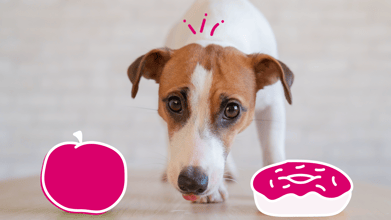Pet Obesity Checklist: Symptoms and Health Risks

Keeping your dog or cat at a healthy weight is an important aspect of wellness care that you can provide to your pet at home. Some studies have shown that as many as one in three cats and dogs in the U.S. are overweight or obese.
As a veterinarian, I try to stress the importance of keeping your furry friend at an optimal weight, as pet obesity can be associated with several health problems.
Let’s review the risk factors, signs, and health implications of pet obesity and answer some of your frequently asked questions about this important topic.
🔑 Key Takeaways:
-
Excess weight can lead to various health problems, including heart disease, diabetes, and joint issues, significantly impacting your pet's quality of life.
-
Regularly monitoring your pet's weight and recognizing the signs of obesity can help prevent more serious health complications.
-
A balanced diet, regular exercise, and routine veterinary check-ups are essential for maintaining a healthy weight.
-
Working closely with your veterinarian can help create a personalized weight management plan.
Is Your Pet at Risk for Obesity?
Several factors contribute to pet obesity:
-
Age: As pets age, their metabolism slows, increasing the risk.
-
Neuter/Spay Status: Altered pets are more likely to become overweight.
-
Gender: While less common in older dogs, obesity affects females more.
-
Overfeeding and High-Caloric Diets: Excessive food intake is a primary culprit.
-
Lack of Exercise: Insufficient physical activity can contribute to weight gain.
-
Medical Conditions: Certain health issues, such as hypothyroidism, can increase a pet’s risk of becoming overweight or obese.
Recognizing the Symptoms of Pet Obesity
As a pet parent, you are in the best position to identify symptoms of obesity early, as you see your furry friend daily. Here are common symptoms to watch out for.
Signs of Obesity in Dogs
-
Shortness of breath
-
Weight gain & excess body fat
-
Distended abdomen & no visible waistline
-
Lethargy
-
Decreased exercise tolerance & reduced stamina
-
Difficulty moving
-
Difficulty getting up & down
-
Difficulty navigating stairs
-
Lack of grooming or inability to groom
-
Poorer coat quality
Is My Dog Overweight?
How to Use the Body Condition Score (BSC) Chart
- Feel Your Dog’s Ribs: Gently feel along your dog’s ribs and chest. An overweight dog will have excessive fat covering the ribs, making them more difficult to feel. An underweight dog’s ribs will feel more “bony” and prominent. If your dog is at a healthy weight, you’ll be able to feel the ribs, but only when pressing gently on them.
- Check Your Dog’s Abs: Get down on your dog’s level and look at your dog’s shape from the side. Check where their chest transitions to their belly. Ideally, this area should have a tapered appearance, called an abdominal “tuck.”
- Look at Your Dog’s Waistline: Look at your dog’s shape from above. Do they have a slightly tapered-in waistline? If so, this is one indicator that your dog may be at a healthy weight.
View Results
Is My Dog Overweight?
1-3 Underweight
A body condition score of 1-3 is generally considered to be too thin. Consult with your vet about introducing more calories into your dog’s diet and rule out any medical causes.
4-5 Just right!
A body condition score of 4-5 is an indicator that your dog is at an ideal weight. If you still have concerns, a vet can advise you best.
6-9 Overweight
A body condition score of 6-9 means that your dog may be overweight or obese. It’s important to check in with your vet about the best plan for your pet.
Share Quiz
Signs Your Cat is Obese
-
Visible weight gain
-
Difficulty jumping or climbing
-
Sitting or lying down more
-
Showing a reluctance to get up and move about
-
Loss of a visible waistline
-
The inability of the pet parent to feel rib bones or hip bones
-
Looking down from above, your cat’s back appears flat, and the cat’s profile looks rectangular
-
Dirty, messy, unkempt hair coat
-
The collar keeps getting tighter
-
Less frequent bowel movements and/or more passing of gas
Is My Cat Overweight?
Is My Cat Overweight?
1. Calculate your cat's current weight.
2. Take their PCL Measurement - a cat’s PCL is the length from the top of the patella (knee) to the end of the calcaneus (ankle). Make sure your cat is standing with their head upright and measure the length of your cat's lower back leg from the knee to the ankle.
3. Enter these two calculations below.
View Results
Your Cat’s BMI is
which means
Interpreting Your Results: What to Do if Your Cat is Underweight or Overweight
Keep in mind that our calculator is meant to serve as a general guide, and there could be a medical reason why your cat is either underweight or overweight. If your cat is not at an ideal weight, it is important to rule out a medical cause for this, so you should first check in with your veterinarian before making any changes.
Once your vet has determined that your cat’s non-ideal weight is not related to an underlying medical cause, you’ll want to work together to create a vet-approved nutrition plan. Your vet can make recommendations about the best foods for your cat, how much to feed them, and help to ensure that any nutrition changes will be healthy for them.
Share Quiz
Health Risks of Pet Obesity
Pet obesity can cause serious health problems and worsen existing problems, reducing the length and quality of your pet's life.
Being overweight or obese puts them at greater risk of conditions such as:
-
Diabetes: Obesity can promote insulin resistance and increase the risk of diabetes.
-
Heart Disease: Excess weight puts strain on the circulatory system and heart.
-
Respiratory distress: Respiratory problems can worsen due to excess fat around the chest and abdomen.
-
High blood pressure: Hypertension can result from excess weight, which puts pressure on the heart and kidneys.
-
Osteoarthritis: Joints experience additional stress from extra weight, leading to arthritis and joint pain.
-
Kidney disease: High blood pressure and conditions secondary to obesity can stress the kidneys more.
-
Anesthetic complications: Obese pets have a higher anesthetic risk.
-
Skin conditions: The inability to groom properly can lead to dander, greasy coats, and skin infections.
-
Liver disease: Fat can accumulate in the liver and eventually impair functioning.
-
Cruciate ligament: Obese pets are more susceptible to knee injuries such as a cruciate ligament tear.
-
Pancreatitis: Excess fat can increase the risk of pancreatitis, and inflammation of the pancreas that can lead to pain and digestive issues.
-
Shorter lifespan: Obesity can contribute to chronic diseases & lower quality of life, decreasing lifespan.
-
Compromised immune function: Obesity can affect the body's ability to respond to infections appropriately.
-
Exercise intolerance or lethargy: Mobility & movement become compromised with excess weight, making it difficult for day-to-day functions
-
Heat intolerance: Obese pets cannot expel heat, thus increasing their risk of life-threatening heat stroke.
Conclusion
Ensuring a healthy weight and preventing obesity for your pet not only reduces the risk of developing health conditions such as heart disease and early arthritis but it also helps to ensure a longer, healthier, more active life.
By working closely with your veterinarian, providing a balanced diet, and ensuring regular exercise, you can help your furry friend live a longer, healthier life. Remember, even small changes can make a big difference.
Discover the Recipe for a Healthy Pet
Consult with one of our vets about your pet’s nutritional needs and long-term health.
Frequently Asked Questions
What are the clinical signs of obesity in animals?
Clinical signs of obesity in pets include:
-
Exercise intolerance and mobility concerns
-
Excessive panting
-
Difficulty getting up, down, or navigating stairs
-
Loss of waistline and impalpable ribs
What is the best indicator if a dog is obese or overweight?
The best indicators if your dog is obese are a lack of waistline, panting excessively during exercise, and mobility concerns.
What could happen to a pet if it were obese?
Obese pets are more susceptible to chronic health conditions such as early arthritis, diabetes, and heart disease.
How do overweight dogs act?
Overweight dogs may be more lethargic and less likely to exercise, show difficulty when moving, and breathe heavier with activity.
How do I know if my cat is obese?
If your cat has no visible waistline and a distended belly, they may be overweight. Consult with your veterinarian about your cat’s healthy weight goals.
How long do obese cats live?
Because of secondary health concerns that can develop in obese cats, they tend to have a lower life expectancy than cats at healthy weights.
Is 17 pounds obese for a cat?
17 pounds may be the average weight for a large breed cat like a Maine coon, but typical household cats generally weigh around 10 pounds, but this weight can vary depending on breed, sex, and age.
What does fat on a cat feel like?
Fat typically feels like a soft layer of cushioning or padding under the skin.






